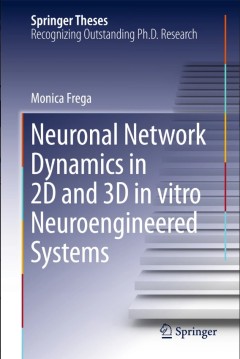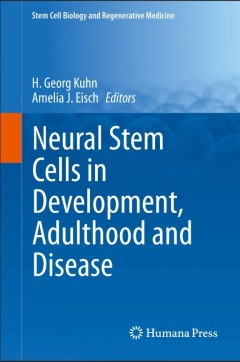Filter by

Endogenous ADP-Ribosylation
This volume gathers the latest exciting findings on ADP-ribosylation from renowned experts in the field. It includes ten chapters, organized into the following three thematic sections: · Evolution and detection of endogenous ADP-ribosylation · ADP-ribosylation by the ARTC family of ADP-ribosyltransferases (R-S-E ARTs) · ADP-ribosylation by the ARTD family of ADP-ribosyltransfe…
- Edition
- -
- ISBN/ISSN
- 978-3-319-10771-4
- Collation
- VIII, 213
- Series Title
- -
- Call Number
- -

Endocannabinoids
There is currently considerable interest in the development of medicines that would enhance endocannabinoid-induced “autoprotection”, for example through inhibition of endocannabinoid metabolizing enzymes or cellular uptake processes or that would oppose endocannabinoid-induced “autoimpairment”. This volume describes the physiology, pathophysiology and pharmacology of the endocannabinoi…
- Edition
- -
- ISBN/ISSN
- 978-3-319-20825-1
- Collation
- XII, 475
- Series Title
- -
- Call Number
- -

Nanotechnology-Based Precision Tools for the Detection and Treatment of Cancer
This book discusses emerging nanotechnology-based tools that have the potential to dramatically impact cancer research, diagnostics, and treatment. Cancer is a complex, devastating, and debilitating disease and, although much progress has been made, novel, more effective diagnostic and treatment options are still needed, especially for advanced cancers. The ultimate goal is to detect cancer ear…
- Edition
- 1
- ISBN/ISSN
- 978-3-319-16554-7
- Collation
- X, 322
- Series Title
- Cancer Treatment and Research
- Call Number
- -

Encyclopedia of Metagenomics Genes, Genomes and Metagenomes. Basics, Methods…
Metagenomics has taken off as one of the major cutting-edge fields of research. The field has broad implications for human health and disease, animal production and environmental health. Metagenomics has opened up a wealth of data, tools, technologies and applications that allow us to access the majority of organisms that we still cannot access in pure culture (an estimated 99% of microbial lif…
- Edition
- -
- ISBN/ISSN
- 978-1-4899-7478-5
- Collation
- 39 b/w illustrations, 178 illustrations in colour
- Series Title
- -
- Call Number
- -

Stem Cells and Cardiac Regeneration
Ischemic heart disease (IHD) and heart failure (HF) are the major causes of morbidity and mortality in Europe and worldwide. IHD and HF patients could benefi t from therapies that would accelerate natural processes of postnatal collateral vessel formation and/or muscle regeneration. Although treatment for acute myocardial infarction has improved over the past decades, there are currently no …
- Edition
- -
- ISBN/ISSN
- 978-3-319-25427-2
- Collation
- -
- Series Title
- -
- Call Number
- -

Neurocytology:Fine Structure of Neurons, Nerve Processes, and Neuroglial Cells
During the second half of the 20th century, the introduction of a variety of new techniques greatly expanded our knowledge of the structure of nerve and neuroglial cells and of the organization of the nervous system at the cellular level. This new information has, however, generally been scattered throughout the literature, making it difficult for investigators to gain an overall vision of the …
- Edition
- 1
- ISBN/ISSN
- 978-3-319-06855-8
- Collation
- XV, 319
- Series Title
- -
- Call Number
- -

Neuronal Tissue-Nonspecific Alkaline Phosphatase (TNAP)
Phosphatases, such as TNAP are fundamental in regulating the roles of cellular, and consequently numerous body functions. TNAP is a ubiquitous enzyme with a wide spectrum of substrates and specificity. Regulation at the cellular level and the lack of TNAP activity is a lethal condition. Recent findings of a highly specific regional, laminar and subcellular localization of TNAP in the cerebral c…
- Edition
- 1
- ISBN/ISSN
- XXII, 395
- Collation
- XXII, 395
- Series Title
- Subcellular Biochemistry
- Call Number
- -

Their World: A Diversity of Microbial Environments
This volume summarizes recent advances in environmental microbiology by providing fascinating insights into the diversity of microbial life that exists on our planet. The first two chapters present theoretical perspectives that help to consolidate our understanding of evolution as an adaptive process by which the niche and habitat of each species develop in a manner that interconnects individua…
- Edition
- -
- ISBN/ISSN
- 978-3-319-28071-4
- Collation
- -
- Series Title
- -
- Call Number
- -

Neuronal Network Dynamics in 2D and 3D in vitro Neuroengineered Systems
The book presents a new, powerful model of neuronal networks, consisting of a three-dimensional neuronal culture in which 3D neuronal networks are coupled to micro-electrode-arrays (MEAs). It discusses the main advantages of the three-dimensional system compared to its two-dimensional counterpart, and shows that the network dynamics, recorded during both spontaneous and stimulated activity, dif…
- Edition
- 1
- ISBN/ISSN
- 2190-5053
- Collation
- XIII, 148
- Series Title
- Springer Theses
- Call Number
- -

Neural Stem Cells in Development, Adulthood and Disease
This comprehensive volume is the first to specifically target developing, adult and diseased neural stem cells. It explores recent advances in the understanding of neural stem cell biology along with strategies that use these cells to tackle neurological diseases and brain aging. Ten inclusive chapters discuss a wide range of topics including neurogenesis, neurodegeneration, demyelinating disea…
- Edition
- 1
- ISBN/ISSN
- 978-1-4939-1907-9
- Collation
- XXI, 202
- Series Title
- Stem Cell Biology and Regenerative Medicine
- Call Number
- -
 Computer Science, Information & General Works
Computer Science, Information & General Works  Philosophy & Psychology
Philosophy & Psychology  Religion
Religion  Social Sciences
Social Sciences  Language
Language  Pure Science
Pure Science  Applied Sciences
Applied Sciences  Art & Recreation
Art & Recreation  Literature
Literature  History & Geography
History & Geography